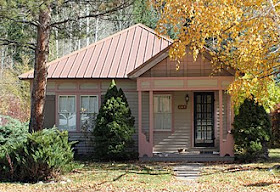 |
| John Cleveland Osgood |
John Cleveland
Osgood was a prominent figure within the coal industry and best remembered for erecting
the town, Redstone, Colorado. Born in Brooklyn on March 6, 1851, Osgood moved
to Burlington, Iowa with his father when he was 6. A few years later, he was
sent to live with relatives in Providence, Rhode Island after his father died. An
office job at a cotton mill taught him business. He moved to New York City at
16 and found work in a Produce Exchange Commission while attending night
school. Afterward, he returned to Burlington and took a job at White Breast
Fuel Company and a position at First National Bank as a cashier.
During his time with First National Bank, he
learned the banking side of the business world. This led to him taking over the
fuel company at age 26 and visiting Colorado to learn more about the state’s
coal resources for the Chicago, Burlington and Quincy railroad. Osgood bought
several tracts of coal land in Colorado and formed the Colorado Fuel Company.
His business grew fast and he eventually merged with Colorado Coal and Iron
Company to become Colorado Fuel and Iron Company. Bessemer Iron Works in
Pueblo, Colorado became the company’s headquarters.
Colorado Fuel and Iron mined about three
quarters of the coal in Colorado, but miner strikes between 1894-1901 proved
costly for the company. Osgood testified before the Colorado General Assembly
that he knew what was best for miners and not the labor unions, going so far as
to declare labor unions a threat to the United States. During the same
time frame, an idea to eliminate labor unions, known as welfare capitalism, was gaining
popularity. Osgood approved this idea, believing a happy and content worker was
a productive worker who didn’t strike, and set about providing for his
employees’ every need by building Redstone, Colorado.
 |
| Coke ovens |
Located west of Pueblo and south of Glenwood
Springs, Redstone was constructed as a company town. Coke ovens were built to
turn coal into coke (see explanation below on coke and coal). To carry the coal
from the Coal Basin mines and the coke to the foundries in Pueblo, the Crystal
River railroad was built. To accommodate employees’ housing needs, Osgood built
84 cottages for married workers and 1 dormitory with 40 rooms for single
workers. The cottages and the dormitory were somewhat of a rarity as they all had
indoor plumbing and electricity. Some of the cottages are still in existence
today, as is the dormitory. To further accommodate his married employees' needs,
Osgood built a school for their children.
 |
| Employee cottage |
Osgood also built the Redstone Club, which
had reading rooms stocked with papers in different languages, weeklies and
magazines. A library, small theater and a bath house were also part of the
Redstone Club, which cost $25,000 to build; $707,000 in today’s market.
Redstone boasted a saloon, with card tables and pool tables. Saloon rules were
strictly enforced, to include a ‘No Treating’ rule, which prevented anyone from
buying a round of drinks to avoid drunkenness. Gambling was kept to penny ante
poker and dime wagers on a game of pool. Rounding off the town was an irrigated
garden, a public barn for employee’s livestock, and a wash house for laundering
clothes, but the crème-de-la-crème to Redstone was and still is Osgood’s
castle, Cleveholm Manor.
 |
| Cleveholm Manor |
Built to impress his second wife, Swedish
Countess Alma Regina Shelgrem, Cleveholm Manor is a 24,000ft English Tudor-style
castle. Designed by New York architects Boal and Harnois, work on the Manor
began in 1897 and was finished in 1901, with a price tag of $50,000 (1.1 million
in today’s market). Sometimes called Redstone Castle, the manor sits on 72
acres and includes servants’ quarters, a gamekeeper’s lodge, carriage house, greenhouse,
and a kennel for dogs. Gate keeper’s homes were erected on the north and south boundaries.
The stable housed horses, cattle and chickens, with a game preserve of deer,
elk and bighorn sheep, and a stocked fishing pond.
Sadly, Cleveholm Manor nearly fell to ruins.
A strike at Colorado mines weakened Osgood’s company. He successfully foiled a
takeover by John Gates from Chicago, but lost to John D. Rockefeller and Jay
Gould in a stock war in 1903. Osgood was forced to abandon his welfare programs,
though he did remain active in combating unions, this time around with
violence. He founded the Victor-American Fuel Company and took up residence in
New York City; his stay at Cleveholm now infrequent. Eventually the manor was
boarded up when Osgood elected to spend time in Palm Springs or cruising to
Europe. He finally returned to the manor with his third wife, Lucille, in 1925
when diagnosed with terminal cancer. He passed in 1926 and Lucille tried to
turn the estate into a resort, but the Depression thwarted her plans.
 |
| Historic Redstone Dormitory/Inn |
Today, Redstone, Colorado is listed on the
National Register of Historic Places and has a population of about 130. The
dormitory is now the Redstone Inn and Cleveholm Manor and the gamekeeper’s
cottage are listed independently on the National Register. The castle contained
75 percent of its furnishing as of 2004 and was bought by the owners of Hotel
Denver in Glenwood Springs and underwent restoration, to include road and utility
work. Currently, it is open for tours.
***Coke is made by heating coal in the
absence of air to drive off impurities to leave an almost pure carbon. Cokes
made from coal are hard, grey, and porous.
 |
| Interior Cleveholm Manor |
 |
| Interior Cleveholm Manor |








No comments:
Post a Comment
Our readers: If you like a post, please consider sharing on your Facebook and/or Twitter pages, and leave a comment. The cowgirls welcome them and will respond if you ask questions. Any Spam will be deleted.